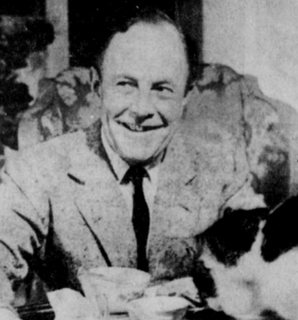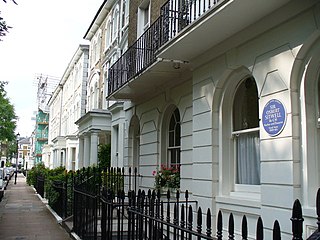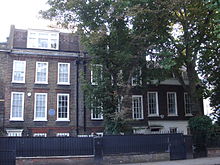
William Somerset Maugham was an English writer, known for his plays, novels and short stories. Born in Paris, where he spent his first ten years, Maugham was schooled in England and went to a German university. He became a medical student in London and qualified as a physician in 1897. He never practised medicine, and became a full-time writer. His first novel, Liza of Lambeth (1897), a study of life in the slums, attracted attention, but it was as a playwright that he first achieved national celebrity. By 1908 he had four plays running at once in the West End of London. He wrote his 32nd and last play in 1933, after which he abandoned the theatre and concentrated on novels and short stories.

Sir Carol Reed was an English film director and producer, best known for Odd Man Out (1947), The Fallen Idol (1948), The Third Man (1949), and Oliver! (1968), for which he was awarded the Academy Award for Best Director.

Eythrope is a hamlet and country house in the parish of Waddesdon, in Buckinghamshire, England. It is located to the south east of the main village of Waddesdon. It was bought in the 1870s by a branch of the Rothschild family, and belongs to them to this day.

King's Road or Kings Road, is a major street stretching through Chelsea and Fulham, both in west London. It is associated with 1960s style and with fashion figures such as Mary Quant and Vivienne Westwood. Sir Oswald Mosley's Blackshirt movement had a barracks on the street in the 1930s.

Gwendoline Maud Syrie Maugham was a leading British interior decorator of the 1920s and 1930s who popularized rooms decorated entirely in white.

John Beverley Nichols was an English writer, playwright and public speaker. He wrote more than 60 books and plays.

The Constant Wife, a play written in 1926 by W. Somerset Maugham, is a comedy whose modern and amusing take on marriage and infidelity gives a quick-witted, alternative view on how to deal with an extramarital affair.

Oliver Falvey Hill was a British architect, landscape architect, and garden designer. Starting as a follower of Edwin Lutyens, in the 1920s he gained a reputation as a designer of country houses. He turned towards architectural modernism in the 1930s, though in doing so he did not abandon his appreciation of natural materials. His plans made abundant use of curving lines. He also became known for luxurious interior decoration. Hill was the architect of the Midland Hotel in Morecambe, Lancashire and of the British pavilion at the Paris Exposition of 1937.

The Casuarina Tree is a collection of short stories set in the Federated Malay States during the 1920s by W. Somerset Maugham. It was first published by the UK publishing house, Heinemann, on September 2, 1926. The first American edition was published shortly afterwards on September 17, 1926 by George H. Doran. It was re-published by Collins in London under the title The Letter: Stories of Crime. The book was published in French translation as Le Sortilège Malais (1928) and in Spanish as Extremo Oriente (1945).

Sibyl Sophie Julia, Lady Colefax was an English interior decorator and socialite in the first half of the twentieth century.

Radnor Walk is a residential street in the Royal Borough of Kensington & Chelsea off the King's Road in London. The houses are mid and late Victorian and the street is part of the Royal Hospital Conservation Area. It was originally called Radnor Street, and was named after John Robartes, 1st Earl of Radnor who died in Chelsea in 1685. It was renamed Radnor Walk in 1937.

The Parish Church of St Luke, Chelsea, is an Anglican church, on Sydney Street, Chelsea, London SW3, just off the King's Road. Ecclesiastically it is in the Deanery of Chelsea, part of the Diocese of London. It was designed by James Savage in 1819 and is of architectural significance as one of the earliest Gothic Revival churches in London, perhaps the earliest to be a complete new construction. St Luke's is one of the first group of Commissioners' churches, having received a grant of £8,333 towards its construction with money voted by Parliament as a result of the Church Building Act of 1818. The church is recorded in the National Heritage List for England as a designated Grade I listed building. The gardens of St Luke's are Grade II listed on the Register of Historic Parks and Gardens.

4 Cheyne Walk is a Grade II* listed house on Cheyne Walk, Chelsea, London, built in 1718 and architecturally in the Queen Anne style. There is a blue plaque noting that the novelist George Eliot lived there until her death. In 2015, it was acquired by former New York City mayor Michael Bloomberg.

The Pheasantry, 152 King's Road, Chelsea, London, is a Grade II listed building that was home to a number of important figures in 1960s London and a small music venue in the 1970s where a number of bands were able to play their first gigs.
The Markham Arms is a former pub at 138 King's Road, London SW3. It closed as a pub in the early 1990s, and is now a branch of the Santander bank.

James Amster was an interior decorator in New York City in the 1960s who created Amster Yard, a New York City designated landmark.

Beaufort Street is a street in Chelsea, London SW3. It runs north to south from Fulham Road to Cheyne Walk, and is bisected by the King's Road.

Drayton Gardens is a residential street linking the areas of Chelsea and South Kensington, London SW10. It runs roughly north to south from Old Brompton Road to Fulham Road.

Oakley Street is in the Royal Borough of Kensington and Chelsea, London. It runs roughly north to south from King's Road to the crossroads with Cheyne Walk and the River Thames, where it continues as the Albert Bridge and Albert Bridge Road. The street was named after Baron Cadogan of Oakley.

Carlyle Square is a garden square off the King's Road in London's Chelsea district, SW3. The square was laid out on market gardens and was originally called Oakley Square. It was later named in honour of the writer Thomas Carlyle in 1872.






















